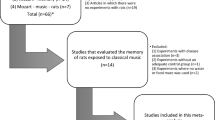Conclusions
-
1.
The number of mistakes made by animals on the first day of formation of an avoidance reaction correlates with a low DA level in the whole brain and with a high NA level in the cortex + corpus striatum.
-
2.
The number of mistakes on the first day of training does not depend on the level of spontaneous motor activity, and mistakes characterize the actual learning process.
Similar content being viewed by others
Literature cited
É. B. Arushanyan and V. A. Otellin, The Caudate Nucleus. Outlines of Its Morphology, Physiology, and Pharmacology [in Russian], Nauka, Leningrad (1976).
V. A. Baturin, Farmakol. Tokslkol.,3, 261 (1977).
A. Yu. Budantsev, Monoaminergic Systems of the Brain [in Russian], Nauka, Moscow(1976).
É. Sh. Matlina, Clinical Biochemistry of the Catecholamines [in Russian], Meditsina, Moscow (1967).
L. Z. Rumshinskii, Mathematical Analysis of Experimental Results [in Russian], Nauka, Moscow (1971).
V. G. Shalyapina, Lab. Delo,5, 313 (1967).
E. Endroczi, Abstracts of Proceedings of the 25th Conference on Problems in Higher Nervous Activity in Memory of I. P. Pavlov, September 26–29, 1977 [in Russian], No. 1, Leningrad (1977), p. 52.
A. Carlsson, Prog. Brain Res.,8, 9 (1964).
A. Carlsson and B. Waldeck, Acta Physiol. Scand.,44, 293 (1958).
U. S. Von Euler and F. Lishajko, Acta Physiol. Scand.,51, 193 (1961).
M. A. Geyer, D. S. Segal, and A. Mandell, J. Physiol. Behav.,8, 53 (1972).
A. Hers, Int. Rev. Neurobiol.,2, 230 (1960).
A. G. Karczmar and G. L. Scudder, Fed. Proc.,26, 1186 (1967).
M. Krause, B. Gwozdz, Z. Steplewski, and T. Pogorzelska, Acta Physiol. Pol.,21, 741 (1970).
S. T. Mason and S. D. Iversen, Brain Res.,134, 513 (1977).
K. E. Moore, Biochem. Pharmacol.,18, 1627 (1969).
C. Rand, D. Quartermain, M. Goldstein, and B. Anagnoste, Science,172, 492 (1971).
G. Winocur and I. A. Mills, J. Comp. Physiol.,68, 552 (1969).
Author information
Authors and Affiliations
Additional information
Translated from Zhurnal Vysshei Nervnoi Deyatel'nosti, Vol. 29, No. 4, pp. 731–736, July–August, 1979.
Rights and permissions
About this article
Cite this article
Saul'skaya, N.B. Correlation between the rate of avoidance conditioning and the brain catecholamine level in rats. Neurosci Behav Physiol 11, 221–226 (1981). https://doi.org/10.1007/BF01184412
Received:
Issue Date:
DOI: https://doi.org/10.1007/BF01184412




